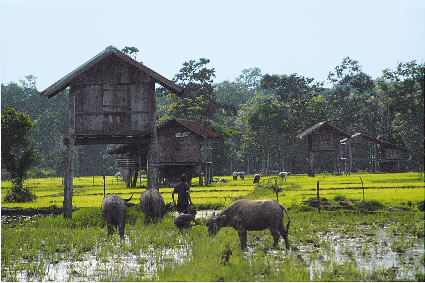A Trans-disciplinary Study on Regional Eco-History in Tropical Monsoon Asia: 1945-2005.
This research project completed a holistic analysis of eco-historical phenomena in tropical monsoon Asia in the decades since WW II. The area has experienced dramatic changes in political regime, devastating wars, modernization, economic globalization, and population growth, all of which have affected both local environments and human populations. The project developed almost 100 flow charts in order to illustrate these processes and their effects. This eco-historical model can be expected to be extensively applied in the analysis of local and global environmental problems.
Major Research Findings
In scrutinizing the eco-history of tropical monsoon Asia in the past several decades, our project aimed to synthesize an eco-linkage model based on about one hundred descriptors of historical interactions between the local environment, human population, and external forces. We were able to identify a number of relevant interactions and events that could be accurately illustrated in themselves and in interaction with a range of other factors so as to depict a complex whole. A range of eco-sensitive phenomena, such as natural and domestic resources, human nutrition and health, and land access rights and eco-policies were identified through exploratory fieldwork.
Our analysis showed that not only state policies but also local community response and decision-making provided the key for understanding the recent process of historical change in the tropical monsoon region.
Rapid modernization and globalization has impacted local environment, modes of life and human health; there is increasing cultivation of cash crops and cash-driven land use, frequent migration, and increased consumption of sugar and fat. Yet, despite these changes, essential elements of the traditional food culture, including consumption of glutinous rice, raw animal meat, and particularly of freshwater fish, remain. In some cases, the incidence of some diseases, such as paragonimiasis and liver fluke, that are associated with traditional diets, remains high.
Our project compiled a database of material culture and photographs collected by Japanese scholars during the past several decades in this region. An eco-chronicle database in Yunnan, China has also been completed for public use.
 |
Photo Rural Landscape in Southern Laos |
Published Results
In addition to numerous articles and papers, we have published sixteen books on various themes and topics (10 Japanese, 4 English and 2 Chinese). The meta database on our findings and collected materials is now available for public use through RIHN's archives (http://db1.chikyu.ac.jp/archives/ ).

